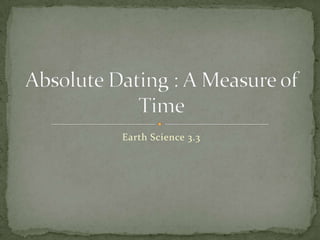Earth Science 3.3 : Absolute Dating: A Measure of Time
•Descargar como PPTX, PDF•
15 recomendaciones•16,182 vistas
Denunciar
Compartir
Denunciar
Compartir

Recomendados
Más contenido relacionado
La actualidad más candente
La actualidad más candente (20)
Destacado
Destacado (19)
Earth Science 3.2 : Relative Dating : Which Came First?

Earth Science 3.2 : Relative Dating : Which Came First?
Earth Science 3.1 : Earth's Story and Those Who First Listened.

Earth Science 3.1 : Earth's Story and Those Who First Listened.
Weather, Layers of the Atmosphere and Energy Transfer

Weather, Layers of the Atmosphere and Energy Transfer
Similar a Earth Science 3.3 : Absolute Dating: A Measure of Time
Similar a Earth Science 3.3 : Absolute Dating: A Measure of Time (20)
5. Place the layers from Figure 3 (below) in order from the youngest .pdf

5. Place the layers from Figure 3 (below) in order from the youngest .pdf
Determining Geologic Time Scale using Absolute and Relative Dating Earth Scie...

Determining Geologic Time Scale using Absolute and Relative Dating Earth Scie...
Más de Chris Foltz
Más de Chris Foltz (20)
Último
God is a creative God Gen 1:1. All that He created was “good”, could also be translated “beautiful”. God created man in His own image Gen 1:27. Maths helps us discover the beauty that God has created in His world and, in turn, create beautiful designs to serve and enrich the lives of others.
Explore beautiful and ugly buildings. Mathematics helps us create beautiful d...

Explore beautiful and ugly buildings. Mathematics helps us create beautiful d...christianmathematics
Último (20)
9548086042 for call girls in Indira Nagar with room service

9548086042 for call girls in Indira Nagar with room service
Interactive Powerpoint_How to Master effective communication

Interactive Powerpoint_How to Master effective communication
Measures of Central Tendency: Mean, Median and Mode

Measures of Central Tendency: Mean, Median and Mode
Beyond the EU: DORA and NIS 2 Directive's Global Impact

Beyond the EU: DORA and NIS 2 Directive's Global Impact
Explore beautiful and ugly buildings. Mathematics helps us create beautiful d...

Explore beautiful and ugly buildings. Mathematics helps us create beautiful d...
Earth Science 3.3 : Absolute Dating: A Measure of Time
- 1. Earth Science 3.3 Absolute Dating : A Measure of Time
- 2. Objectives: Describe how radioactive decay occurs. Explain how radioactive decay relates to radiometric dating. Identify four types of radiometric dating. Determine the best type of radiometric dating to use to date an object.
- 3. Radioactive Decay Absolute dating any method of measuring the age of an event or object in years. To determine the absolute ages of fossils and rocks, scientists analyze isotopes of radioactive elements. Isotopes atoms of the same element that have the same number of protons but different numbers of neutrons.
- 4. Most isotopes are stable, meaning that they stay in their original form. Other isotopes are unstable. Scientists call unstable isotopes radioactive. Radioactive decay Radioactive isotopes tend to break down into stable isotopes of the same or other elements.
- 5. Because radioactive decay occurs at a steady rate, Scientists can use the relative amounts of stable and unstable isotopes present in an object to determine the object’s age. Dating Rocks — How Does It Work? In radioactive decay, an unstable radioactive isotope of one element breaks down into a stable isotope. The stable isotope may be of the same element or of a different element. Parent isotope The unstable radioactive isotope. Daughter isotope The stable isotope produced by the radioactive decay of the parent isotope.
- 6. The rate of radioactive decay is constant so scientists can compare the amount of parent material with the amount of daughter material to date rock. The more daughter material there is the older the rock is.
- 7. Radiometric Dating Radiometric dating Determining the absolute age of a sample, based on the ratio of parent material to daughter material. If you know the rate of decay for a radioactive element in a rock you can figure out the absolute age of the rock. Half-life the time needed for half of a sample of a radioactive substance to undergo radioactive decay. After every half-life, the amount of parent material decrease by one-half.
- 8. Types of Radiometric Dating Scientists use different radiometric-dating methods based on the estimated age of an object. There are four radiometric-dating techniques. Potassium-Argon Method Potassium-40 has a half-life of 1.3 billion years, and it decays leaving a daughter material of argon. This method is used mainly to date rocks older than 100,000years. Uranium-Lead Method Uranium-238 is a radioactive isotope with a half-life of 4.5 billion years. Uranium-238 decays in a series of steps to lead-206. The uranium-lead method can be used to date rocks more than 10 million years old.
- 9. Rubidium-Strontium Method The unstable parent isotope rubidium-87 forms a stable daughter isotope strontium-87. The half-life of rubidium-87 is 49 billion years This method is used for rocks older than 10 million years. Carbon-14 Method Carbon is normally found in three forms, the stable isotopes carbon-12 and carbon-13, and the radioactive isotope carbon-14. Living plants and animals contain a constant ratio of carbon-14 to carbon-12. Once a plant or animal dies, no new carbon is taken in. The amount of carbon-14 begins to decrease as the plant or animal decays. The half-life of carbon-14 is 5,730 years. The carbon-14 method of radiometric dating is used mainly for dating things that lived within the last 50,000 years.